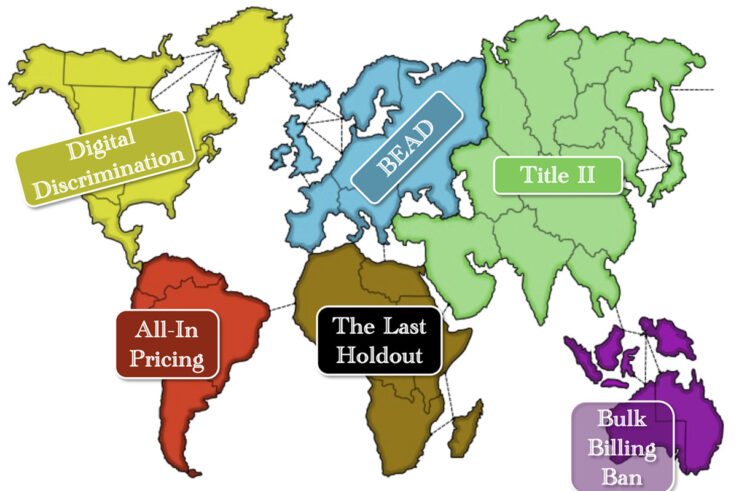It appears that White House’s zeal for progressive-era legal theory has … progressed (or regressed?) further. Late last week President Obama signed an Executive Order that nominally claims to direct executive agencies (and “strongly encourages” independent agencies) to adopt “pro-competitive” policies. It’s called Steps to Increase Competition and Better Inform Consumers and Workers to Support Continued Growth of the American Economy, and was produced alongside an issue brief from the Council of Economic Advisors titled Benefits of Competition and Indicators of Market Power.
TL;DR version: the Order and its brief do not appear so much aimed at protecting consumers or competition, as they are at providing justification for favored regulatory adventures.
In truth, it’s not exactly clear what problem the President is trying to solve. And there is language in both the Order and the brief that could be interpreted in a positive light, and, likewise, language that could be more of a shot across the bow of “unruly” corporate citizens who have not gotten in line with the President’s agenda. Most of the Order and the corresponding CEA brief read as a rote recital of basic antitrust principles: price fixing bad, collusion bad, competition good. That said, there were two items in the Order that particularly stood out.
The (Maybe) Good
Section 2 of the Order states that
Executive departments … with authorities that could be used to enhance competition (agencies) shall … use those authorities to promote competition, arm consumers and workers with the information they need to make informed choices, and eliminate regulations that restrict competition without corresponding benefits to the American public. (emphasis added)
Obviously this is music to the ears of anyone who has thought that agencies should be required to do a basic economic analysis before undertaking brave voyages of regulatory adventure. And this is what the Supreme Court was getting at in Michigan v. EPA when it examined the meaning of the phrase “appropriate” in connection with environmental regulations:
One would not say that it is even rational, never mind “appropriate,” to impose billions of dollars in economic costs in return for a few dollars in health or environmental benefits.
Thus, if this Order follows the direction of Michigan v. EPA, and it becomes the standard for agencies to conduct cost-benefit analyses before issuing regulation (and to review old regulations through such an analysis), then wonderful! Moreover, this mandate to agencies to reduce regulations that restrict competition could lead to an unexpected reformation of a variety of regulations – even outside of the agencies themselves. For instance, the FTC is laudable in its ongoing efforts both to correct anticompetitive state licensing laws as well as to resist state-protected incumbents, such as taxi-cab companies.
Still, I have trouble believing that the President — and this goes for any president, really, regardless of party — would truly intend for agencies under his control to actually cede regulatory ground when a little thing like economic reality points in a different direction than official policy. After all, there was ample information available that the Title II requirements on broadband providers would be both costly and result in reduced capital expenditures, and the White House nonetheless encouraged the FCC to go ahead with reclassification.
And this isn’t the first time that the President has directed agencies to perform retrospective review of regulation (see the Identifying and Reducing Regulatory Burdens Order of 2012). To date, however, there appears to be little evidence that the burdens of the regulatory state have lessened. Last year set a record for the page count of the Federal Register (80k+ pages), and the data suggest that the cost of the regulatory state is only increasing. Thus, despite the pleasant noises the Order makes with regard to imposing economic discipline on agencies – and despite the good example Canada has set for us in this regard – I am not optimistic of the actual result.
And the (maybe) good builds an important bridge to the (probably) bad of the Order. It is well and good to direct agencies to engage in economic calculation when they write and administer regulations, but such calculation must be in earnest, and must be directed by the learning that was hard earned over the course of the development of antitrust jurisprudence in the US. As Geoffrey Manne and Josh Wright have noted:
Without a serious methodological commitment to economic science, the incorporation of economics into antitrust is merely a façade, allowing regulators and judges to select whichever economic model fits their earlier beliefs or policy preferences rather than the model that best fits the real?world data. Still, economic theory remains essential to antitrust law. Economic analysis constrains and harnesses antitrust law so that it protects consumers rather than competitors.
Unfortunately, the brief does not indicate that it is interested in more than a façade of economic rigor. For instance, it relies on the outmoded 50 firm revenue concentration numbers gathered by the Census Bureau to support the proposition that the industries themselves are highly concentrated and, therefore, are anticompetitive. But, it’s been fairly well understood since the 1970s that concentration says nothing directly about monopoly power and its exercise. In fact, concentration can often be seen as an indicator of superior efficiency that results in better outcomes for consumers (depending on the industry).
The (Probably) Bad
Apart from general concerns (such as having a host of federal agencies with no antitrust expertise now engaging in competition turf wars) there is one specific area that could have a dramatically bad result for long term policy, and that moreover reflects either ignorance or willful blindness of antitrust jurisprudence. Specifically, the Order directs agencies to
identify specific actions that they can take in their areas of responsibility to build upon efforts to detect abuses such as price fixing, anticompetitive behavior in labor and other input markets, exclusionary conduct, and blocking access to critical resources that are needed for competitive entry. (emphasis added).
It then goes on to say that
agencies shall submit … an initial list of … any specific practices, such as blocking access to critical resources, that potentially restrict meaningful consumer or worker choice or unduly stifle new market entrants (emphasis added)
The generally uncontroversial language regarding price fixing and exclusionary conduct are bromides – after all, as the Order notes, we already have the FTC and DOJ very actively policing this sort of conduct. What’s novel here, however, is that the highlighted language above seems to amount to a mandate to executive agencies (and a strong suggestion to independent agencies) that they begin to seek out “essential facilities” within their regulated industries.
But “critical resources … needed for competitive entry” could mean nearly anything, depending on how you define competition and relevant markets. And asking non-antitrust agencies to integrate one of the more esoteric (and controversial) parts of antitrust law into their mission is going to be a recipe for disaster.
In fact, this may be one of the reasons why the Supreme Court declined to recognize the essential facilities doctrine as a distinct rule in Trinko, where it instead characterized the exclusionary conduct in Aspen Skiing as ‘at or near the outer boundary’ of Sherman Act § 2 liability.
In short, the essential facilities doctrine is widely criticized, by pretty much everyone. In their respected treatise, Antitrust Law, Herbert Hovenkamp and Philip Areeda have said that “the essential facility doctrine is both harmful and unnecessary and should be abandoned”; Michael Boudin has noted that the doctrine is full of “embarrassing weaknesses”; and Gregory Werden has opined that “Courts should reject the doctrine.” One important reason for the broad criticism is because
At bottom, a plaintiff … is saying that the defendant has a valuable facility that it would be difficult to reproduce … But … the fact that the defendant has a highly valued facility is a reason to reject sharing, not to require it, since forced sharing “may lessen the incentive for the monopolist, the rival, or both to invest in those economically beneficial facilities.” (quoting Trinko)
Further, it’s really hard to say when one business is so critical to a particular market that its own internal functions need to be exposed for competitors’ advantage. For instance, is Big Data – which the CEA brief specifically notes as a potential “critical resource” — an essential facility when one company serves so many consumers that it has effectively developed an entire market that it dominates? ( In case you are wondering, it’s actually not). When exactly does a firm so outcompete its rivals that access to its business infrastructure can be seen by regulators as “essential” to competition? And is this just a set-up for punishing success — which hardly promotes competition, innovation or consumer welfare?
And, let’s be honest here, when the CEA is considering Big Data as an essential facility they are at least partially focused on Google and its various search properties. Google is frequently the target for “essentialist” critics who argue, among other things, that Google’s prioritization of its own properties in its own search results violates antitrust rules. The story goes that Google search is so valuable that when Google publishes its own shopping results ahead of its various competitors, it is engaging in anticompetitive conduct. But this is a terribly myopic view of what the choices are for search services because, as Geoffrey Manne has so ably noted before, “competitors denied access to the top few search results at Google’s site are still able to advertise their existence and attract users through a wide range of other advertising outlets[.]”
Moreover, as more and more users migrate to specialized apps on their mobile devices for a variety of content, Google’s desktop search becomes just one choice among many for finding information. All of this leaves to one side, of course, the fact that for some categories, Google has incredibly stiff competition.
to the extent that inclusion in Google search results is about “Stiglerian” search-cost reduction for websites (and it can hardly be anything else), the range of alternate facilities for this function is nearly limitless.
The troubling thing here is that, given the breezy analysis of the Order and the CEA brief, I don’t think the White House is really considering the long-term legal and economic implications of its command; the Order appears to be much more about political support for favored agency actions already under way.
Indeed, despite the length of the CEA brief and the variety of antitrust principles recited in the Order itself, an accompanying release points to what is really going on (at least in part). The White House, along with the FCC, seems to think that the embedded streams in a cable or satellite broadcast should be considered a form of essential facility that is an indispensable component of video consumers’ choice (which is laughable given the magnitude of choice in video consumption options that consumers enjoy today).
And, to the extent that courts might apply the (controversial) essential facilities doctrine, an “indispensable requirement … is the unavailability of access to the ‘essential facilities’[.]” This is clearly not the case with much of what the CEA brief points to as examples of ostensibly laudable pro-competitive regulation.
The doctrine wouldn’t apply, for instance, to the FCC’s Open Internet Order since edge providers have access to customers over networks, even where network providers want to zero-rate, employ usage-based billing or otherwise negotiate connection fees and prioritization. And it also doesn’t apply to the set-top box kerfuffle; while third-parties aren’t able to access the video streams that make-up a cable broadcast, the market for consuming those streams is a single part of the entire video ecosystem. What really matters there is access to viewers, and the ability to provide services to consumers and compete for their business.
Yet, according to the White House, “the set-top box is the mascot” for the administration’s competition Order, because, apparently, cable boxes represent “what happens when you don’t have the choice to go elsewhere.” ( “Elsewhere” to the White House, I assume, cannot include Roku, Apple TV, Hulu, Netflix, and a myriad of other video options that consumers can currently choose among.)
The set-top box is, according to the White House, a prime example of the problem that
[a]cross our economy, too many consumers are dealing with inferior or overpriced products, too many workers aren’t getting the wage increases they deserve, too many entrepreneurs and small businesses are getting squeezed out unfairly by their bigger competitors, and overall we are not seeing the level of innovative growth we would like to see.
This is, of course, nonsense. Consumers enjoy an incredible amount of low-cost, high quality goods (including video options) – far more than at any point in history. After all:
From cable to Netflix to Roku boxes to Apple TV to Amazon FireStick, we have more ways to find and watch TV than ever — and we can do so in our living rooms, on our phones and tablets, and on seat-back screens at 30,000 feet. Oddly enough, FCC Chairman Tom Wheeler … agrees: “American consumers enjoy unprecedented choice in how they view entertainment, news and sports programming. You can pretty much watch what you want, where you want, when you want.”
Thus, I suspect that the White House has its eye on a broader regulatory agenda.
For instance, the Department of Labor recently announced that it would be extending its reach in the financial services industry by changing the standard for when financial advice might give rise to a fiduciary relationship under ERISA. It seems obvious that the SEC or FINRA could have taken up the slack for any financial services regulatory issues – it’s certainly within their respective wheelhouses. But that’s not the direction the administration took, possibly because SEC and FINRA are independent agencies. Thus, the DOL – an agency with substantially less financial and consumer protection experience than either the SEC or FINRA — has expansive new authority.
And that’s where more of the language in the Order comes into focus. It directs agencies to “ensur[e] that consumers and workers have access to the information needed to make informed choices[.]” The text of the DOL rule develops for itself a basis in competition law as well:
The current proposal’s defined boundaries between fiduciary advice, education, and sales activity directed at large plans, may bring greater clarity to the IRA and plan services markets. Innovation in new advice business models, including technology-driven models, may be accelerated, and nudged away from conflicts and toward transparency, thereby promoting healthy competition in the fiduciary advice market.
Thus, it’s hard to see what the White House is doing in the Order, other than laying the groundwork for expansive authority of non-independent executive agencies under the thin guise of promoting competition. Perhaps the President believes that couching this expansion in free market terms ( i.e. that its “pro-competition”) will somehow help the initiatives go through with minimal friction. But there is nothing in the Order or the CEA brief to provide any confidence that competition will, in fact, be promoted. And in the end I have trouble seeing how this sort of regulatory adventurism does not run afoul of separation of powers issues, as well as assorted other legal challenges.
Finally, conjuring up a regulatory version of the essential facilities doctrine as a support for this expansion is simply a terrible idea — one that smacks much more of industrial policy than of sound regulatory reform or consumer protection.




